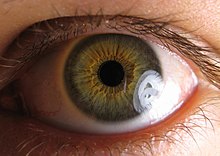


In an optical system, the entrance pupil is the optical image of the physical aperture stop, as 'seen' through the front (the object side) of the lens system. The corresponding image of the aperture as seen through the back of the lens system is called the exit pupil. If there is no lens in front of the aperture (as in a pinhole camera), the entrance pupil's location and size are identical to those of the aperture. Optical elements in front of the aperture will produce a magnified or diminished image that is displaced from the location of the physical aperture. The entrance pupil is usually a virtual image: it lies behind the first optical surface of the system.
The entrance pupil is a useful concept for determining the size of the cone of rays that an optical system will accept. Once the size and the location of the entrance pupil of an optical system is determined, the maximum cone of rays that the system will accept from a given object plane is determined solely by the size of the entrance pupil and its distance from the object plane, without any need to consider ray refraction by the optics. [1]
In photography, the size of the entrance pupil (rather than the size of the physical aperture stop) is used to calibrate the opening and closing of the diaphragm aperture. The f-number ("relative aperture"), N, is defined by N = f / EN, where f is the focal length and EN is the diameter of the entrance pupil. [2] Increasing the focal length of a lens (i.e., zooming in) will usually cause the f-number to increase, and the entrance pupil location to move further back along the optical axis.
The center of the entrance pupil is the vertex of a camera's angle of view [3] and consequently its center of perspective, perspective point, view point, projection center [4] or no-parallax point. [5] This point is important in panoramic photography without digital image processing, because the camera must be rotated around the center of the entrance pupil to avoid parallax errors in the final, stitched panorama. [6] [7] Panoramic photographers often incorrectly refer to the entrance pupil as a nodal point, which is a different concept. Depending on the lens design, the entrance pupil location on the optical axis may be behind, within or in front of the lens system; and even at infinite distance from the lens in the case of telecentric systems.
The entrance pupil of the human eye, which is not quite the same as the physical pupil, is typically about 4 mm in diameter. It can range from 2 mm ( f/8.3) in a very brightly lit place to 8 mm (f/2.1) in the dark. [8]
Most optical systems are designed with a single aperture stop, and therefore have a single entrance pupil. In some cases, however, different elements serve as the aperture stop for objects at different distances. [1] In such cases, the system will have different entrance pupils for different object planes. Similarly, vignetting can cause different lateral locations at a given object plane to have different aperture stops, and therefore different entrance pupils. [1]
See also
References
- ^ a b c Hecht, Eugene (2017). "5.3.2 Entrance and Exit Pupils". Optics (5th ed.). Pearson. ISBN 978-1-292-09693-3.
- ^ Jacobson, Ralph; et al. (1988). The Manual of Photography (8th ed.). Focal Press. ISBN 0-240-51268-5. p.49
- ^ Greivenkamp, John E. (2004). Field Guide to Geometrical Optics. SPIE Field Guides vol. FG01. Bellingham, Wash: SPIE. p. 27. ISBN 978-0-8194-5294-8. OCLC 53896720.
- ^ Lenhardt, Karl. "Optical Measurement Techniques with Telecentric Lenses" (PDF). Schneider Kreuznach. Archived from the original (PDF) on September 24, 2015. Retrieved Oct 14, 2014.
- ^ Littlefield, Rik (Feb 6, 2006). "Theory of the "No-Parallax" Point in Panorama Photography" (PDF). ver. 1.0. Retrieved Jan 14, 2007.
- ^ Kerr, Douglas A. (2005). "The Proper Pivot Point for Panoramic Photography" (PDF). The Pumpkin. Archived from the original (PDF) on Apr 7, 2008. Retrieved Jan 14, 2007.
- ^ van Walree, Paul. "Misconceptions in photographic optics". Archived from the original on April 19, 2015. Retrieved Jan 14, 2007. Item #6.
- ^ Hecht, Eugene (1987). Optics (2nd ed.). Addison Wesley. ISBN 0-201-11609-X.
External links
- Stops and Pupils in Field Guide to Geometrical Optics Greivenkamp, John E, 2004
- Entrance and exit pupil, RP Photonics Encyclopedia